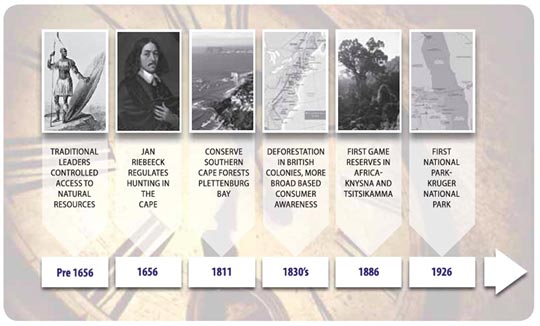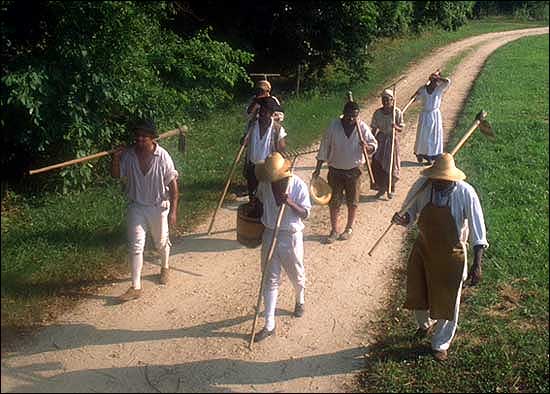Pre-colonial period
The land that is known as South Africa has a history of conservation. Traditionally, people have always lived in harmony with nature and the philosophies of sustainability and conservation were inherent in their society. As hunters and gatherers, the indigenous people of this country depended on natural resources for their survival. Prior to European colonisation access to natural resources were controlled in the following ways:
- Resource use was influenced by religious beliefs and was affected by local traditional healers.
- There were superstitions against killing certain species like hyena, hammerkop or chameleon.
- People were prohibited from hunting or eating their totem animals (these included eland, zebra, monkeys, squirrels or crocodiles).
- Scarce or valuable products (like ivory, pangolin meat or leopard pelts) were given to their rulers.
Areas were demarcated for specific purposes, and it is possible that this was done to prevent over-use of these species. These areas were small and were set aside for various religious purposes and included sacred forests, burial sites and hills for ceremonies and rituals.
Colonial period
During this period, additional settlement saw the natural resources being exploited. In 1656 Jan van Riebeeck gave instructions to regulate hunting in the Cape. The Southern Cape forests were valuable to the British Navy and from 1811 measures were introduced to conserve the forests around Plettenberg Bay. By the 1830s rapid deforestation in the British colonies in India, Africa and Mauritius led to increased conservation awareness. By the mid-19th century there was an active and influential conservation community in the Cape. It was concerned with hunting and forests, and with the soil and the veldt. It was also responsible for the first game reserves in Africa, located in the Knysna and Tsitsikamma forests in 1886.
The creation of parks often resulted in communities being forcibly relocated to new areas, or losing their land. Reserves were fenced off, and the communities lost their rights and access to resources within the reserves. Military tactics were used and fines were issued to offenders. Wild animals would escape from the parks into community land and damage crops and livestock. All these factors increased feelings of resentment by local communities towards the Park Authorities.
Conservation became elitist and access to parks required social privileges. There was little or no consideration for the communities, who were seen as threats to the environment. Over-grazing, over-population, cutting and burning grass, and poaching were contentious issues. Many early education programmes were motivated by the idea that people were a threat and sought to improve attitudes and change practices.
This period created distinct divisions of the land: European settlement areas, African communal areas and the beginning of the demarcation of conservation areas. The African population was forced into smaller areas of land. The notorious Land Acts of 1913 and 1936 legislated this divide, and left indigenous people with only 13% of the total land area in South Africa. Traditional authority structures were weakened and the functions of the chiefs were passed on to the magistrates.
Chiefs and tribal councils were responsible for making and keeping the rules for resource control. Chieftaincies were powerful institutions that were respected and obeyed by local people. Their authority was absolute. The combination of different types of controls regulated the use of natural resources and protected the resource base.
Apartheid era
The apartheid era reinforced the division between communal managed areas and formally managed PAs. Homelands were formed and the management of the PAs became fragmented. Some protected areas became the responsibility of homeland governments, with each having its own legislation and management authority. Relationships between communities and government were strained due to the exclusion of communities from PAs.
A new era of Park Management began when South Africa became a democracy in 1994. For example the law that prevented rural communities from accessing areas where they could collect firewood, medicinal plants and graze their livestock. The land restitution process saw thousands of black people claiming ownership of land, and most of this land falls within Protected Areas. Successful land claims presented new economic opportunities for the claimants who had been moved away from their land. The government is now faced with the challenge of seeing that previously disadvantaged people are supported and advised to ensure they get the benefits they deserve, whilst upholding their conservation mandates under the NEM:PPA.
The shift affected the approaches towards conservation and development in South Africa, which led to various people and parks type projects and other forms of community based natural resource management (CBNRM) programmes.
Since 1994, political changes in South Africa have fundamentally changed the attitudes of PAs management agencies and owners. Previously communities were excluded from playing a role in protecting the environment. Today people are becoming shareholders and new practices for PAs are being created - allowing rural people to play a critical role.
The Cape Vidal memorandum leading to to the P&PP
The Cape Vidal meeting carried the new spirit of people and nature-friendly conservation and the hope for the survival of PAs in South Africa. With the end of apartheid there was an opportunity to reclaim land as well as rights and access to natural resources. However, there was a lack of clarity around land ownership and rights and this fuelled conflict between communities and conservation agencies. The communities’ vision for their land development was linked to conservation, but was frustrated by a slow process of land claim settlements. This was a hurdle for the communities trying to reclaim their dignity and exercise their rights that would bring benefits to their people. The communities agreed that their land could be managed for conservation as long as they were actively involved in the process.
Linking People and Parks in South Africa
In South Africa, the land reform process and land restitution in particular, has been the main motivating factor for greater equity and more inclusive and broad-based forms of natural resource management in PAs.




